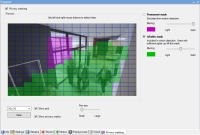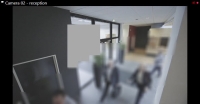Privacy masking (explained)
Privacy masking (explained)
With privacy masking, you can define which areas of the video from a camera you want to cover with privacy masks when shown in the clients. For example, if a surveillance camera covers a street, you can cover certain areas of a building (could be windows and doors) with privacy masks, to protect the privacy of residents. In some countries, this is a legal requirement.
You can specify privacy masks as either solid or blurred. The masks cover both live, recorded, and exported video.
Privacy masks are applied and locked to an area of the camera image, so the covered area does not follow the pan-til-zoom movements, but constantly covers the same area of the camera image. On some PTZ cameras, you can enable position based privacy masking on the camera itself.
There are two types of privacy masks:
- Permanent privacy mask: Areas with this type of mask are always covered in the clients. Can be used to cover areas of the video that never requires surveillance, like public areas, or areas where surveillance is not allowed. Motion detection is excluded from areas with permanent privacy masks
- Liftable privacy mask: Areas with this type of mask can be temporarily uncovered in XProtect Smart Client by users with permission to lift privacy masks. If the logged in XProtect Smart Client user does not have the permission to lift privacy masks, the system asks for an authorized user to approve of the lift.
Privacy masks are lifted until timeout or the user reapply them. Be aware that privacy masks are lifted on video from all cameras that the user has access to
If you upgrade from a 2017 R3 system or older with privacy masks applied, the masks will be converted to liftable masks.
When a user exports or playbacks recorded video from a client, the video includes the privacy masks configured at the time of recording, even if you have changed or removed the privacy masks later. If privacy protection is lifted when exporting, the exported video does not include the liftable privacy masks.
If you change privacy masking settings very often, for example once a week, your system can potentially be overloaded.
Example of the Privacy masking tab with privacy masks configured:
And this is how they appear in the clients:
You can inform the client users about the settings of permanent and liftable privacy masks.



